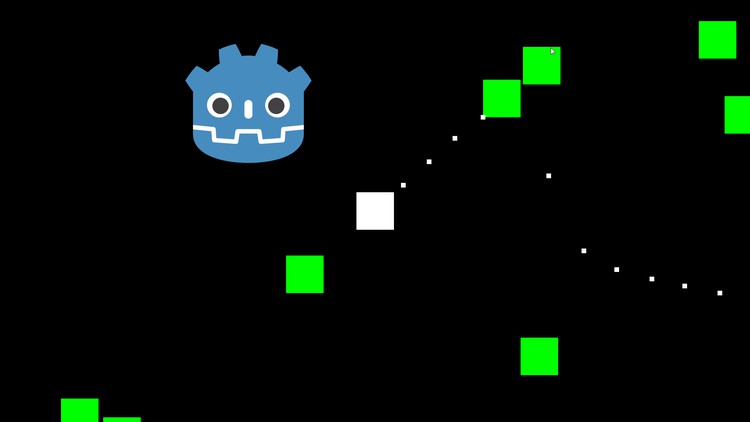
Become a Game Developer
What you will learn
☑ Create games using the Godot Engine
☑ Write code in GDScript (programming language)
☑ Create and use custom variables, functions, classes, and objects
☑ Combine nodes to create custom scenes
Description
In this course, you’ll learn the fundamentals of programming and game development using the Godot game engine.
You don’t need any programming experience to take this course. Everything will be taught as we go.
We’ll start out by covering the very basics of programming, such as variables, functions, and loops.
You’ll also learn how to use arrays and dictionaries to store data, and how to control the flow of logic with if-else statements.
You’ll learn about object-oriented programming (OOP) as we cover classes, objects, and inheritance.
You’ll become familiar with using nodes and scenes as building blocks for your game, and controlling its behavior through scripts.
The course is designed to teach you good programming habits, such as the use of static typing, assertions, and prefixed local variable names.
Every line of code will be broken down and explained in detail, so that you’ll understand exactly what it does and how.
We’ll be creating 3 different games in this course: a side-scroller, a trivia game, and a top-down shooter.
By the end of the course, you’ll have enough programming knowledge to create your own games and applications.
You will then be prepared and able to follow along with intermediate-level Godot tutorials and courses with relative ease.
English
Language
Content
Introduction
Setting up Godot
01 – Nodes, Scenes, and Scripts
Constants
02 – Constants
Variables
03 – Variables
Data Types and Static Typing
04-1 – Data Types
04-2 – Static Typing
Functions – Arguments and Return Values
05-1 – Functions
05-2 – Function Return Values
Functions – Return Types, Parameters and Signature
06-1 – Function Return Types
06-2 – Function Parameters and Signature
Type Inference
07 – Type Inference
For-Loops
08-1 – For Loop
08-2 – For Loop – Part 2
Array Indexes and For-Loop Iterator
09-1 – Array indexes
09-2 – Array indexes – Part 2
09-3 – For Loop – Part 3
Classes and Class Functions
10 – Classes and Class Functions
Array Class Functions
11 – Array Class Functions
Dictionaries
12-1 – Dictionaries
12-2 – Dictionaries – Part 2
12-3 – Dictionaries – Part 3
12-4 – Dictionaries – Part 4
12-5 – Dictionaries – Part 5
Setting Array Elements and Dictionary Values
13-1 Setting Array Elements
13-2 Setting Dictionary Values
Array and Dictionary Pitfalls
14-1 Array-Dict Outdated Values
14-2 Outdated Values Solution
14-3 Dictionary Mistakes
Assertions and Boolean Not
15-1 – Assertions
15-2 – Assertions – Part 2 – NOT symbol
15-3 – Assertions – Part 3
Dictionary Setter Function
16-1 – Dictionary Setter Function
16-2 – Dictionary Setter Function – Part 2
Comparison Operators
17 – Comparison Operators
Math Operators
18-1 – Math Operators
18-2 – Modulo Operator
18-3 – Modulo Operator – Part 2
If-Statements
19 – If-Statements
If-Else-Statements
20 – If-Else-Statements
If-Elif-Else-Statements
21 – If-Elif-Else-Statements
Ternary If-Statement
22 – Ternary If
Match Statements
23 – Match Statements
Nested If-Statements
24 – Nested If-Statements
Nested Match Statements
25 – Nested Match Statements
Variable Scope – Overshadowing and Prefix
26-1 – Variable Scope
26-2 – Variable Scope – Part 2 – Variable Overshadowing
26-3 – Variable Scope – Part 3 – Underline Prefix
Helper Functions
27 – Helper Functions
Boolean And
28 – Boolean And
Boolean Or
29 – Boolean Or
Enums
30-1 – Named Enum
30-2 – Unnamed Enum
30-3 – Enum Custom Values
30-4 – Enum Pros and Cons
Break
31 – Break
Continue
32 – Continue
Objects and Classes
33-1 – Objects and Classes
33-2 – Objects and Classes – Part 2
SceneTree and Scene Root
34 – SceneTree and Scene Root
Creating the Player Class
35 – Creating the Player Class
Creating the Wall class
36 – Creating the Wall class
Finalizing Game
37 – Finalizing Game
Trivia Game
Trivia Game 01 – Creating the Main Scene
Trivia Game 02 – FRAME Scene
Trivia Game 03 – BTN Scene
Trivia Game 04 – BTN Hover Signal
Trivia Game 05 – BTN Hover Animation
Trivia Game 06 – BTN Unhover
Trivia Game 07 – BTN Press
Trivia Game 08 – Getting BTN Label Node
Trivia Game 09 – Setting BTN BG Color
Trivia Game 10 – Setting BTN Border Color
Trivia Game 11 – Setting BTN Text Color
Trivia Game 12 – Setting BTN Text
Trivia Game 13 – BTN Color Constants
Trivia Game 14 – BTN Clickable and Hoverable Bools
Trivia Game 15 – LABEL Scene
Trivia Game 16 – BTNGrid
Trivia Game 17 – BTNGrid Script
Trivia Game 18 – Changing the Display Size
Trivia Game 19 – Resizing BTNGrid BTNs
Trivia Game 20 – Questions Singleton
Trivia Game 21 – Questions Singleton – part 2
Trivia Game 22 – Questions Singleton – part 3
Trivia Game 23 – Setting BTNGrid Text
Trivia Game 24 – TriviaGrid
Trivia Game 25 – G.gd Singleton
Trivia Game 26 – Disable and Darken
Trivia Game 27 – GameOverLabel
Trivia Game 28 – GameOverLabel – part 2
Trivia Game 29 – Finishing the Project
Zombie Shooter
Zombie Shooter – Step 1 – Player
Zombie Shooter – Step 2 – Zombie
Zombie Shooter – Step 3 – Pixel Snapping
Zombie Shooter – Step 4 – Bullet
Zombie Shooter – Step 5 – Destroying Bullets
Zombie Shooter – Step 6 – Destroying Zombies
Zombie Shooter – Step 7 – Preventing Crashes
Zombie Shooter – Step 8 – Shooting Automatically
Zombie Shooter – Step 9 – Spawning Zombies
Zombie Shooter – Step 10 – Adding Walls
Zombie Shooter – Step 11 – Collision Layers
Zombie Shooter – Step 12 – Zombie Spawn Speedup
Zombie Shooter – Step 13 – Damaging the Player
Zombie Shooter – Step 14 – GameOverLabel
Zombie Shooter – Step 15 – Restarting the Game
Zombie Shooter – Step 16 – Finishing the Course